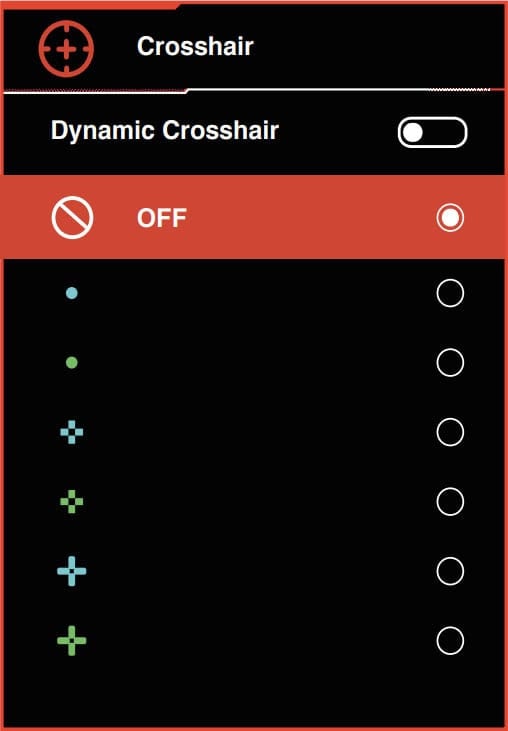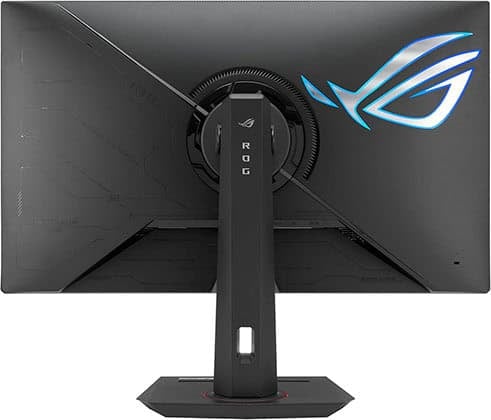Bottom Line
The ASUS XG32UCG is a decent 32″ 4K 160Hz IPS gaming monitor with 1080p 320Hz Dual Mode, but we recommend investing around $100 more in a mini LED model for proper HDR support.
The ASUS XG32UCG is a 32″ 4K 160Hz IPS gaming monitor with 1080p 320Hz Dual Mode. Here’s what you need to know about it.
Image Quality
Based on an IPS panel, the ASUS ROG Strix XG32UCG provides you with 178° wide viewing angles, meaning that the image will remain consistent regardless of the angle you’re looking at the screen.
It also has a factory-calibrated sRGB mode, which ensures accurate colors without oversaturation, making the monitor fit for professional color-critical work.
Alternatively, you can use its native color gamut that covers 95% of the wider DCI-P3 color space for more saturated and vibrant colors.
As expected from an IPS display, the static contrast ratio is 1,000:1, so blacks won’t be as deep as that of VA panels with a typical contrast ratio of around 3,000:1, but these panels have other drawbacks, such as narrower viewing angles, unstable VRR performance and slower pixel response time.
Another drawback of IPS technology is IPS glow, characterized as visible glowing around the corners of the screen at certain viewing angles.
However, this effect is mainly noticeable when displaying a dark image in a dark room with a high brightness setting. It can be mitigated by using proper brightness levels (increase it in bright rooms, decrease it in dark rooms) and by placing some ambient lighting behind the screen.
Next, the ASUS XG32UCG monitor has a peak brightness of 350-nits, meaning that it can get more than bright enough under normal lighting conditions.
It also supports HDR (High Dynamic Range), but since it lacks proper display hardware (OLED panel or a mini LED backlight with hundreds or thousands of dimming zones), you won’t be getting a true HDR viewing experience.
Some HDR content might benefit from dithered 10-bit color depth for smoother gradients, DCI-P3 color mapping for more vibrant and accurate colors, and a slight bump in peak brightness to 400-nits, but details in shadows and highlights won’t be up to par for proper HDR.
Moving on, the 4K UHD resolution on a 31.5″ viewable screen of the monitor provides you with a high pixel density of roughly 140 PPI (pixels per inch), resulting in plenty of screen space with sharp details and text. Some users prefer to use scaling at this pixel density, but it’s not necessary.

With a press of a button, you can activate the Dual Mode feature, which changes the monitor’s resolution to 1920×1080 with a maximum refresh rate of 320Hz. Naturally, 1080p on a 31.5″ screen will be more blurry, but this is less noticeable in games where the added motion clarity of 320Hz might be a worthy trade-off to some users.
Performance
In addition to providing you with smoother motion, 320Hz also makes the gameplay experience more responsive by reducing input latency from around 4ms at 160Hz to just 2ms.
The ASUS XG32UCG has adjustable response time overdrive from 0 to 20, in increments of 1.
The default setting of ’10’ should provide optimal performance; however, depending on how warmed-up the display is and your room temperature, you could try increasing it by a few points to squeeze out a bit of performance. Use Blur Busters’ UFO ghosting test to find the sweet spot for you.
The monitor supports variable refresh rate (VRR) for tear-free gameplay up to 160FPS at 4K or 320FPS at 1080p with AMD FreeSync Premium and NVIDIA G-SYNC Compatible certifications, as well as HDMI 2.1 VRR.
Next, there’s the ELMB (Extreme Low Motion Blur) feature, which uses backlight strobing to reduce perceived motion blur at the cost of image brightness as long as you’re refresh rate is 85Hz or higher.
It also supports ELMB-Sync, which allows you to use ELMB and VRR simultaneously to both reduce motion blur and keep screen tearing at bay.
You can adjust strobe length (the trade-off between motion clarity and sacrificed screen brightness, with a 5-level setting) and strobe phase (which part of the image will be the clearest with minimal strobe crosstalk or image duplications).
Another downside of ELMB is that it introduces screen flickering. It’s invisible to the human eye, but it can cause headaches after prolonged use to those sensitive to screen flickering.
The backlight of the monitor is otherwise flicker-free and there’s a low-blue light filter mode available.
Features

On the rear of the monitor, there’s a directional joystick for quick and easy navigation through the OSD (On-Screen Display) menu, as well as a dedicated power button and a hotkey for the Dual Mode feature.
Besides the typical image adjustment tools (brightness, contrast, color temperature, etc.), the ASUS XG32UCG also has some advanced settings, such as sharpness (VividPixel), gamma (from 1.8 to 2.6), 6-axis hue/saturation, DSC toggle, automatic input detection and PiP/PbP.
You can also use ASUS’ DisplayWidget desktop application to make all OSD-related adjustments using your keyboard and mouse.
Useful gaming features include:
- On-screen timers
- Refresh rate tracker
- Sniper – zooms in the area around your crosshair
- Crosshair overlays – including Dynamic mode that changes color depending on the background
- Aspect ratio control – 24.5″ and 27″ screen size simulation, 4:3, full, equivalent and pixel by pixel
- Shadow Boost – improves visibility in dark scenes, including Dynamic mode that prevents over-brightening of already bright areas
Design & Connectivity

The stand of the monitor is robust and offers height adjustment up to 110mm, +/- 25° swivel, -5°/20° tilt and 100x100mm VESA mount compatibility.
There’s no pivot option, but the monitor has a 1/4″ tripod socket on the top of the stand riser and a phone holder on the base.
The screen has a light matte anti-glare coating that prevents reflections without making the image too grainy, and there’s customizable AuraSync RGB lighting on the rear of the monitor.
Connectivity options include DisplayPort 1.4 with DSC, HDMI 2.1, USB-C with DP Alt Mode and 15W Power Delivery, and a headphone jack.
Price & Similar Monitors
The ASUS XG32UCG price ranges from $450 to $600. At $600, it’s too expensive, but at $450, it offers decent value for the price if you’re not interested in HDR.
Keep in mind that for $550 – $600, you can get the KTC M32P10 with a 32″ 4K 144Hz IPS panel, DisplayHDR 1000 and a 1152-zone mini LED FALD backlight for a proper HDR viewing experience. It also has a USB-C port with higher 45W Power Delivery and integrated KVM, but no Dual Mode.
If you want a cheaper 32″ 4K high refresh rate IPS gaming monitor, there’s the ASUS VG32UQA1A variant for $330 – $400. It has a tilt-only stand and no Dual Mode.
You may also be interested in the MSI MAG 321CUPDF.
It has a 32″ 4K 160Hz curved VA panel with 1080p 320Hz Dual Mode and a higher contrast ratio for deeper blacks for $400, but suffers from slower response times, narrower viewing angles and unstable VRR performance. If you’re not sensitive to these drawbacks, it’s worth considering.
For more options and information, check out our comprehensive and always up-to-date best gaming monitor buyer’s guide.
Conclusion
Overall, the ASUS XG32UCG is an excellent gaming monitor, but we recommend investing a bit more in a mini LED model for an immersive HDR viewing experience.
Specifications
| Screen Size | 31.5-inch |
| Resolution | 3840×2160 (Ultra HD) |
| Panel Type | IPS |
| Aspect Ratio | 16:9 (Widescreen) |
| Refresh Rate | 4K 160Hz 1080p 320Hz |
| Response Time | 1ms (GtG) |
| Motion Blur Reduction | ELMB-Sync |
| Adaptive-Sync | FreeSync Premium, HDMI 2.1 VRR G-SYNC Compatible, (48-160Hz, 48-320Hz) |
| Ports | DisplayPort 1.4, HDMI 2.1, USB-C (DP Alt Mode, 15W PD) |
| Other Ports | Headphone Jack |
| Brightness | 350 cd/m² |
| Brightness (HDR) | 400 cd/m² |
| Contrast Ratio | 1000:1 (static) |
| Colors | 1.07 billion (8-bit + FRC) 95% DCI-P3 |
| HDR | VESA DisplayHDR 400 |
| VESA | Yes (100x100mm) |
The Pros:
- High pixel density
- Accurate, consistent and vibrant colors with sRGB mode
- Fast response time, low input lag
- Plenty of features, including VRR + MBR up to 320FPS
- Ergonomic design
The Cons:
- IPS glow and mediocre contrast ratio (as expected from this panel technology)
- Design lacks pivot option
- Limited power delivery over USB-C
- No USB hub or KVM




